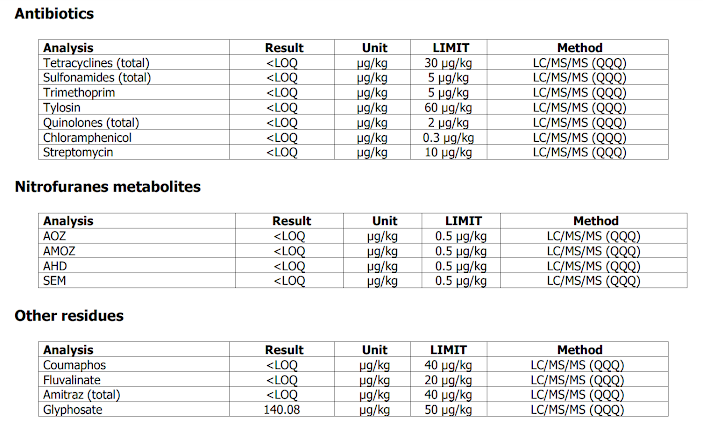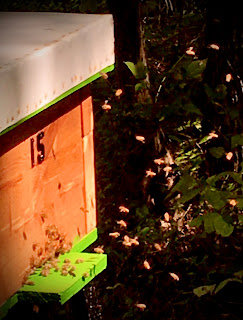Our Honey is Better and We Have the Data to Prove It!
With this in mind, we set out to prove that our honey is, indeed, different than the run-of-the mill honeys you can buy in supermarkets and farmers’ markets around Kentucky and Tennessee. According to an article in Vice (NOTE: all sources cited in this blog post are referenced at the end), “Honey can deceive in many ways. Some honeys are heated to high temperatures, for easier manipulation and to avoid crystallization, but are presented as raw. Others are diluted with different kinds of sugar or syrups, made from rice, beet, corn, or other plans. Honey can be extracted while it’s still immature - when it’s not yet honey, but a nectar product - or labeled as local when instead it comes from overseas.” Sadly, such alterations are routine for the vast majority of honeys sold in big box stores from large-scale producers. According to the Vice article, some 70% of the 110 different brands of honey from stores in the US tested as adulterated, mislabeled, and otherwise fraudulent. Cheap honey is certainly cheap, but it may not even be honey! Buyer beware and always remember that you are going to get what you pay for.
Irish Acres Honey is artisanal honey at its best. We are truly local, our honey is unseated, filtered lightly, and comes from hives that are not treated with any chemicals. We cannot, of course, control where the bees forage as they will typically cover an area of about 8000 acres around the hive and fly as far as two or three miles from the hive in search of pollen and nectar. However, by giving them an environment that is rich in forage, we can influence them to stay closer to home
So we decided to invest in some expensive testing of our honey from Sweetwater Scientific, the lab cited in the Vice article and that has a global reputation for food testing. Working closely with the University of Missouri, Sweetwater offers testing of several food products, but notably it is one of the very few labs in the world to test honey for chemicals and pollen.
We are very pleased with our results!
Here are the major findings from our analysis:
No antibiotics were found - this is because our hives are chemical-free and we do not treat our beehives for disease or pests; instead, we let our bees do that themselves and by practicing “Darwinian Beekeeping,” our bees get stronger and hardier and more resistant with every passing year.
Our honey is chock full of pollen! While many store bought honeys are completely free of pollen (filtered heavily to hide the country of origin), our honey is brimming with pollen, thus making it more of a health food than a sweetener.
The one chemical found in our honey is glyphosate (aka Roundup), which we cannot control. As it is used widely throughout Kentucky, it is almost impossible to have honey that is totally free of this chemical. However, the level is well within the acceptable limits as described by the Environment Working Group.
Let’s look at the analysis in more detail, starting with the antibiotics and other chemical residues (including Roundup). In the chart below, the “result” column is in PPD (parts per billion), unless the amount is too small to measure, which shows as <LOQ (limit of quantitation):
Antibiotics and nitfuranes metabolites are all used in treating hives by some Beekeepers. At Irish Acres Apiary, we refuse to use ANY antibiotics as we do not want to select for weaker bees and stronger diseases, which is the end result of regular treatments. Instead, we allow the weak bees to die off so the stronger ones survive that can handle common bee maladies. Our honey is absolutely free of all these antibiotics.
What are the “other residues” noted in the analysis? Coumaphos, Fluvalinate, and Amitraz are all chemicals placed in beehives through various treatment methods to treat varroa mites, a very common problem in beekeeping. Mites are an especially bad problem in large apiaries, where beehives are packed close together, and in migratory beekeeping used for pollination services. By spacing our hives far apart in our forest apiary, and not having other bee yards in our vicinity, we are able to maintain lower mite levels that the bees can manage themselves naturally, without added chemicals.
Glyphosate, however, is a very common chemical that is mostly associated with Roundup, widely used for row-crop agriculture, hay production, and other farming of commodity crops. At Irish Acres, we never use any chemicals on our farm, but many farms in the surrounding area of the county do, so it is inevitable that our bees will forage crops that are treated with Roundup - especially fields of clover used for hay production. Bees will carry minute amounts of glyphosate back to the hive via the pollen they collect, as well as on their own bodies when they come into contact with treated crops.
Now, glyphosate is considered carcinogenic and Bayer, which produces Roundup, has had to pay out over $16 billion to settle lawsuits related to Roundup. However, it has been determined to be “safe” at very low levels, although obviously it’s best to avoid it entirely if you can. Sadly, it is because of Roundup that it is pretty much not possible to have certified “organic” honey in the U.S. - because bees will forage over an area of roughly 8000+ acres and that entire area would have to be certified organic within at least a one mile radius of the hive. Organic honeys thus come from countries where Roundup is not allowed and all agriculture chemicals are much more tightly controlled.
The European Union only allows a benchmark of 50 PPB for glyphosate in food. The Environment Working Group (EWG) in the US allows a higher level of 160 PPB, but the Food and Drug Administration and the Environmental Protection Agency do not mandate any levels at all, quite possibly due to pressure from industry lobbyists.
Irish Acres Honey tested at 140.08 PPB for glyphosate, below the level set by the EWG. While this is 140 PPB higher than we would like to see, it is sadly out of our control due to the prevalence of Roundup in Kentucky farming practices. That said, it is a safe bet that any honey purchased from any producer in Kentucky or Tennessee is going to have similar or even higher levels.
In a nutshell, our artisanal honey is chemical free from imposed treatments and the level of glyphosate is well within safe limits.
Now let’s look at the pollen analysis. According to the Sweetwater Scientific report, “The extraction yielded a very clean preparation with well-preserved pollen. The dominant pollen tax on is closer, with two types of clover represented. Mustard family and poison ivy/oak pollen are noted in moderate quantities, followed by rose family. Tupelo pollen is present as a minor constituent. Total pollen concentration is calculated at slightly more than 8,000 pollen per cc of honey.” The data below from the spreadsheet provided show the different pollen and their quantities.
This, of course, begs the question of what is a good pollen level to be found in honey? Almost all processed honey from the big box stores has zero grains of pollen in it as much commercial honey is heated and heavily filtered to remove all pollen from it, thereby disguising the country of origin. In this way, honey from China can be passed off as coming from Vietnam or even Tennessee as there are no pollen markers in it to note it's region of origin. As the chart below shows, Irish Acres honey is rich in pollen with some 8000 pollen grains per cc. While this is not a lot in and of itself (there are roughly 2.5 billion grains in a teaspoon of bee pollen), it is an added health benefit to our honey and proves that our honey is not heavily filtered. A common pollen count in raw, unfiltered honey is 1200 grains per cc, for example.
We are able to preserve the pollen in our honey because it is only lightly filtered to remove major debris such as bee parts, while preserving the pollen and bits of beeswax that add nutrition to the rich nectar sources that comprise our honey. We also do not centrifuge all of our honey, but rather cut out the full honeycomb and press it to squeeze out the honey, which also adds pollen, bee bread, and some wax to the honey. All of this combines to make our honey richer, tastier, and healthier.
So when you shop for honey, the most important thing to remember is to buy local and know your beekeeper! At Irish Acres, we are a small, artisanal producer running an apiary designed for the health of our bees, letting them live out their lives as undisturbed as possible in a rich environment without chemicals or other additives in their hives, feeding only on their own honey and the food products they gather themselves. The honey they produce is shared with you after being processed with care, in order to preserve its rich taste and health benefits. Our honey is different - and worth every penny, Enjoy!
The following links will take you to some of the sources we used for this blog post:
“Your Fancy Honey Might Not Actually Be Honey,” Vice, March 6, 2020. https://www.vice.com/en/article/884kq4/your-fancy-honey-might-not-actually-be-honey
“How Does EWG Set a ‘Health Benchmark’ for Glyphosate Exposure?,” Environmental Working Group. https://www.ewg.org/news-and-analysis/2018/08/how-does-ewg-set-health-benchmark-glyphosate-exposure
“Glyphosate: The Cancer-causing Roundup Chemical Found In Children’s Cereal,” Environmental Working Group, https://www.ewg.org/key-issues/toxics/glyphosate
“Catch The Buzz – Fda Finds Glyphosate In Honey. What Now?,” Bee Culture, August 31, 2018. https://www.beeculture.com/catch-the-buzz-fda-finds-glyphosate-in-honey-what-now/
“Glyphosate Residue Concentrations In Honey Attributed Through Geospatial Analysis To Proximity Of Large-scale Agriculture And Transfer Off-site By Bees,” PLOS ONE (via National Institute of Health), July 11, 2018. https://www.ncbi.nlm.nih.gov/pmc/articles/PMC6040695/
“New EWG Testing Shows Glyphosate Still In Popular Breakfast Cereals,” Detox Project, June 13, 2019. https://detoxproject.org/new-ewg-testing-shows-glyphosate-still-in-popular-breakfast-cereals/

